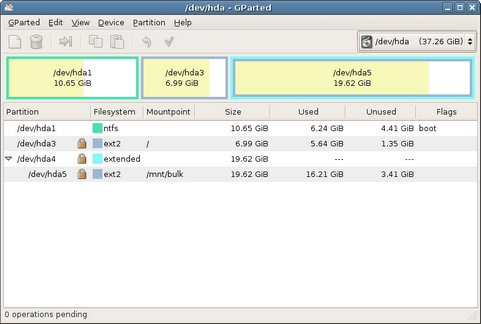![]() Woensdag kwam Citrix met XenDesktop 3, met daarin ‘Streaming Desktop’. Daarmee kan het besturingssysteem vanaf een server via het netwerk worden gestart. Daarmee wordt alle kracht van een desktop benut, maar houdt de it-afdeling toch de mogelijkheid om alles centraal te beheren. “Dit werkt het beste wanneer je over een relatief krachtige thin client beschikt, of over een aantal gestandaardiseerde pc’s”, aldus een woordvoerder van Citrix. Bij Desktop Streaming kunnen er geen grote afwijkingen in de hardware zijn, omdat alle hardware configuratie-informatie in het image zit dat wordt gestreamd. Dus hoe minder afwijkingen, hoe meer mensen van dat ene image gebruik kunnen maken. In vergelijk met de traditionele Server Based Computing concepten heb je dus veel minder servers nodig, omdat de desktop niet meer op de server draait. Desktop Streaming zal onderdeel uitmaken van de ‘Advanced’, ‘Enterprise’ en ‘Platinum’ versies van XenDesktop 3. Deze worden eind februari leverbaar. De prijzen van deze drie zijn respectievelijk 195, 295 en 395 dollar per gelijktijdige gebruiker. Twee versies zijn er ook zonder Desktop Streaming; Standard en Express. Die laatste is gratis. Bedrijven die wel nog gewoon de desktops op de server willen laten draaien, kunnen er dankzij een zekere vorm van optimalisatie met XenDesktop 3 meer draaien op één server; bij een server met twee quad-core processors tussen de 50 en 55 desktops, aldus Citrix. In het beheer is ‘profile management’ geïntegreerd, dankzij techniek die met de overname van Sepago vorig jaar in handen van Citrix kwam.
Woensdag kwam Citrix met XenDesktop 3, met daarin ‘Streaming Desktop’. Daarmee kan het besturingssysteem vanaf een server via het netwerk worden gestart. Daarmee wordt alle kracht van een desktop benut, maar houdt de it-afdeling toch de mogelijkheid om alles centraal te beheren. “Dit werkt het beste wanneer je over een relatief krachtige thin client beschikt, of over een aantal gestandaardiseerde pc’s”, aldus een woordvoerder van Citrix. Bij Desktop Streaming kunnen er geen grote afwijkingen in de hardware zijn, omdat alle hardware configuratie-informatie in het image zit dat wordt gestreamd. Dus hoe minder afwijkingen, hoe meer mensen van dat ene image gebruik kunnen maken. In vergelijk met de traditionele Server Based Computing concepten heb je dus veel minder servers nodig, omdat de desktop niet meer op de server draait. Desktop Streaming zal onderdeel uitmaken van de ‘Advanced’, ‘Enterprise’ en ‘Platinum’ versies van XenDesktop 3. Deze worden eind februari leverbaar. De prijzen van deze drie zijn respectievelijk 195, 295 en 395 dollar per gelijktijdige gebruiker. Twee versies zijn er ook zonder Desktop Streaming; Standard en Express. Die laatste is gratis. Bedrijven die wel nog gewoon de desktops op de server willen laten draaien, kunnen er dankzij een zekere vorm van optimalisatie met XenDesktop 3 meer draaien op één server; bij een server met twee quad-core processors tussen de 50 en 55 desktops, aldus Citrix. In het beheer is ‘profile management’ geïntegreerd, dankzij techniek die met de overname van Sepago vorig jaar in handen van Citrix kwam.
Daarnaast is de manier waarop de XenDesktop omgaat met multimedia veranderd; de server zal voortaan de gecomprimeerde data naar de desktop sturen, waarna de desktop voor de verwerking (het uitpakken) zorgt. Dit moet de ervaring voor de gebruiker verbeteren, waarmee XenDesktop interessanter wordt voor een grotere groep. Hiervoor roept Citrix de ‘HDX’-techniek in het leven, een techniek die er ook voor zorgt dat meer usb-apparaten aan een client kunnen worden aangesloten.
Gnome Partition Editor 0.4.2
Vandaag is er een nieuwe versie van Gnome Partition Editor verschenen, te weten 0.4.2. Met GParted is het mogelijk om een harde schijf te partitioneren en bestaande partities te wijzigen. Het programma zelf is niet zo groot, maar meestal wordt het in de vorm van een live-cd uitgebracht waardoor het op elk platform gebruikt kan worden. De laatste live-cd die nu van SourceForge kan worden opgehaald, bevat op dit moment echter nog stable-versie 0.4.1-2 en testbuild 0.4.2 pre-release 1, maar daar komt hopelijk snel verandering in. Hieronder is te vinden wat er allemaal in de 0.4.2-release veranderd is:
Key changes include:
-
Added support for ext4 file system
-
Support for ext4 is built into version 2.6.28 of the Linux kernel
-
e2fsprogs version 1.41.0 or higher required
-
-
Created application help manual
-
Updated gparted manual page
-
Made text beside field labels selectable (i.e., copy/paste UUID)
-
Added lvm2 physical volume detection
-
Reduced file system information disk reads to improve performance
-
Fixed application crash when saving details and locale not set
-
Enhanced copy/paste checks when MBR/EBR involved
See the Release Notes for more details.

Website
GParted
Download
http://downloads.sourceforge.net/gparted/gparted-0.4.2.tar.bz2?modt…
OpenOffice.org 3.0.1 introduceert grammatica controle
V an gratis kantoorpakket OpenOffice.org is versie 3.0.1 uitgebracht. In deze uitgave wordt grammatica controle geïntroduceerd. Verder zijn vooral kleine fouten opgelost die in de vorige versie waren geslopen. Vandaag is de Engelse OpenOffice.org 3.0.1 vrijgegeven. De Nederlandse vertaling volgt binnen twee weken.
Vorig jaar oktober kwam OpenOffice.org 3.0 uit. Een grote uitgave van het kantoorpakket met veel nieuwe functies. Vandaag is een zogeheten bugfix release van OpenOffice.org verschenen die veel kleine fouten oplost. Versie 3.0.1 heeft echter ook nieuwe functionaliteit: zo is grammatica-controle toegevoegd aan OpenOffice.org.
Vooralsnog is alleen de Engelse versie van OpenOffice.org 3.0.1 uitgegeven. De Nederlandse versie wordt binnen twee weken verwacht.
GroupWise 7.0 SP3 Hot Patch 2 and GroupWise 8.0 Hot Patch 1
 There are hotpatches (client + server) for GW7 (GW7 SP3 HP2) and GW8 (GW8 HP1), which contain numerous fixes (see below), and also security fixes concerning a WebAccess vulnerability, which is, according to Dean Lythgoe’s blog
There are hotpatches (client + server) for GW7 (GW7 SP3 HP2) and GW8 (GW8 HP1), which contain numerous fixes (see below), and also security fixes concerning a WebAccess vulnerability, which is, according to Dean Lythgoe’s blog , a ” very low ” severity threat/concern. But an issue nonetheless.
, a ” very low ” severity threat/concern. But an issue nonetheless.
Download
GW7 SP3 HP2.
or
GW8 HP1.
For info on the vulnerability, check out TID’s …
7002319 ,
,
7002320 ,
,
7002321 ,
,
7002322 ,
,
7002502 .
.
WebSite: http://support.novell.com
Xen 3.3.1
Xen is een ‘virtuele machine hypervisor’ voor het x86-platform en laat meerdere besturingssystemen gelijktijdig op één systeem draaien zonder de prestaties drastisch te beïnvloeden. Voor meer informatie over Xen en de bijbehorende community verwijzen we jullie door naar deze en deze pagina. Op dit moment worden alleen Linux en Netbsd ondersteund als hostsystemen, maar men is druk bezig om ook andere besturingssystemen, zoals Solaris, volledig te ondersteunen. De ontwikkelaars hebben deze maand Xen 3.3.1 met de volgende aankondiging uitgebracht:
The Xen 3.3 release contains architectural improvements and new user-visible features, compared to 3.2, including:
- Power management (P & C states) in the hypervisor
- HVM emulation domains (qemu-on-minios) for better scalability, performance and security
- PVGrub: boot PV kernels using real GRUB inside the PV domain
- Better PV performance: domain lock removed from pagetable-update paths
- Shadow3: optimisations to make this the best shadow pagetable algorithm yet, making HVM performance better than ever
- Hardware Assisted Paging enhancements: 2MB page support for better TLB locality
- CPUID feature levelling: allows safe domain migration across systems with different CPU models
- PVSCSI drivers for SCSI access direct into PV guests
- HVM framebuffer optimisations: scan for framebuffer updates more efficiently
- Device passthrough enhancements
- Full x86 real-mode emulation for HVM guests on Intel VT: supports a much wider range of legacy guest OSes
- New qemu merge with upstream development
- Many other changes in both x86 and IA64 ports
Xen 3.3.1 is a maintenance release in the 3.3 series.
Website
Xen
Download
http://xen.org/download/
tweakers.net
Novell GroupWise Mobile Server 3.0.1 for Windows powered by Nokia Intellisync e Media Kit
 Novell GroupWise® Mobile Server 3 for Windows*, powered by Intellisync*, enables customers to synchronize e-mail, appointments, tasks, contacts, and notes between GroupWise and hundreds of mobile devices. This capability is the result of a partnership between Novell and Nokia* Corporation to integrate Intellisync’s wireless "push" e-mail and Personal Information Management (PIM) synchronization technology with GroupWise.
Novell GroupWise® Mobile Server 3 for Windows*, powered by Intellisync*, enables customers to synchronize e-mail, appointments, tasks, contacts, and notes between GroupWise and hundreds of mobile devices. This capability is the result of a partnership between Novell and Nokia* Corporation to integrate Intellisync’s wireless "push" e-mail and Personal Information Management (PIM) synchronization technology with GroupWise.
- Increased productivity because users can access and share information regardless of location.
- Increased flexibility because users can choose the devices and form factors they prefer.
- Reduced management workload because administrators are able to manage e-mail on a variety of devices with one solution.
- Reduced hardware costs because servers dedicated to support various mobile device types can be consolidated.
Nieuws over GroupWise Mobility – Is dat nou goed of slecht?

Gisteren (22 januari) werd op www.open-horizons.net de eerste publieke uitspraak gepubliceerd over de toekomst van GroupWise mobility middels een quote van Alex Evans op deze pagina. Voor de zeer nabije toekomst verandert er nog niet veel – GroupWise Mobile Server zal minimaal tot oktober 2009 ondersteund worden en tegen die tijd zou de nieuwe oplossing op basis van ActiveSync beschikbaar moeten zijn. Is dat nou goed of slecht nieuws? Ik had recentelijk met diverse groepen daar wat discussies over, ondermeer met wat deelnemers van de GMS lab tijdens de EMEA Summit in november als met de deelnemers aan de GW8 upgrade training eerder deze week en die discussies hadden een verrassende uitkomst? Lees verder en oordeel zelf – is dit nu goed of slecht nieuws voor de GroupWise community?
First of all, let’s have a look at where this is coming from. A few years ago, Novell and Intellisync came to an agreement about the usage of Intellisync Mobile Server (IMS) and to use this technology as the basis for what has become known as GroupWise Mobile Server (GMS). Only a few weeks after this announcement Finnish based Nokia bought US based Intellisync for more than 400 million dollar, as they wanted to expand their offerings into this segment of the market as well. This way Novell was now teaming up with Nokia and this has brought us the GMS which is now being used at many GroupWise sitesoften with great success. Part of the agreement was that IntelliSync would create a version of GMS that would run on Linux as well and that version has become available in 2008.
Then in October 2008 everyone was quite surprised to hear that Nokia deciced to stop the development of all their behind-the-firewall solutions. This included IMS and by throwing their 400+ million dollar investment in Inetllisync out the window the GMS was obviously hurt as well. In that same time frame Nokia announced that their (future) phones will support ActiveSync server as well, for some a bit of a surprise as Nokia had never been a big fan of Microsoft until that moment (see also this page). Some people have suggested that signing up a deal about supporting ActiveSync and stopping with new development on IMS are linked, but it’s always difficult to see if that is true indeed.
Even before that decision was announced, as the contract with IntelliSync was already a few years old and was up for renewal, Novell must have been looking at the continuation of the GMS project or at alternatives. The problem with the mobile market is that even for huge companies like Nokia things are changing quickly. Obviously Novell now had to speed up the project to find a replacement for GMS.
During the Hands-On lab about GMS during the EMEA Summit in November I had a very good discussion with the attendees about these developments. We all didn’t like the fact that GMS was going to be a dead-end, although support and even new developments for GMS would not end for quite some time. To summarize a long discussion, here’s what our group came up with:
A. Novell could buy GMS and/or Intellisync – Interesting thought, however considering the 400+ million dollar Nokia had paid for Intellisync and what Novell would really buy for a few hunderd million (technology, developers, patents) – would it be worth the money?
B. Novell develops a new GMS themselves – With regards to the backend, the server part, the Novell engineers would probably have been quite capable of creating a very well integrated solution. Actually, they were quite involved with GMS development anyway. However, the real problem here is the device support – even for big companies like Nokia and Microsoft the fast developments in this market space create huge problems, for example resulting in the fact that Microsoft sync server will only work with the latest Windows mobile versions, an attitude that Novell would never be able to"sell" to its customers.
C. Novell adopts one of the partner solutions as their own – There are several partners like NotifyLink, RIM, Toffa and several others that have a strong connection to GroupWise and deliver solutions that support GroupWise. However, taking over an existing partner or making a new OEM does not solve the problem as mentioned under B. – device support would still be a major concern.
During our discussion we have looked at several options and then turned things around – what if we look at it from the device and not from the server? First of all there is SyncML, an open standard which is included in many phones already and can be installed as separate client on almost all other devices. Then there is RIM, as they offer a solution to connect non-BlackBerry devices to their RIM server, some Nokia phones already supported this. And then there is ActiveSync, obviously embedded in the WindowsMobile devices but alos supported by the popular iPhone as well as by Nokia and more and more other manufacturers.
So that’s where we end up now: Novell will adopt the ActiveSync technology and basically frees themselves of the device support dilemma – let the market solve that themselves. And they can now concentrate on building a new GMS server which supports ActiveSync, either by doing this themselves or hiring some other company to do that for them.
So is that good or bad? Well, it’s bad that Nokia dropped IntelliSync, it’s good now that within a few months Novell already has a clear vision on the future of GroupWise mobility. Me and many others will follow this project very closely and critically test whatever comes at us – currently I’m not a big ActiveSync fan yet, so I need to adapt and start loving a piece of Microsoft technology. To be continued…



